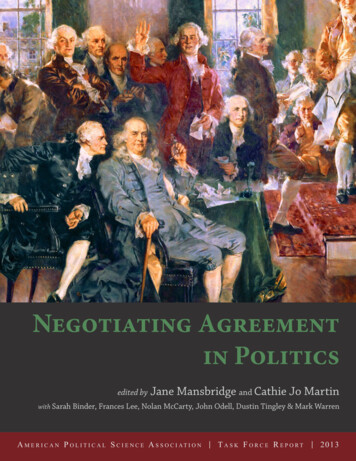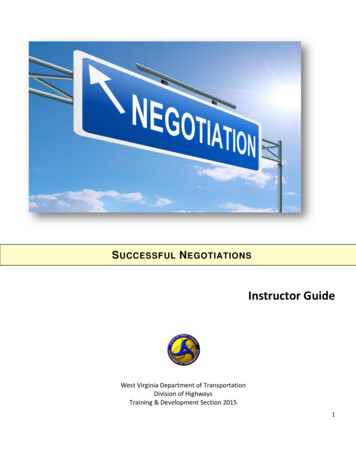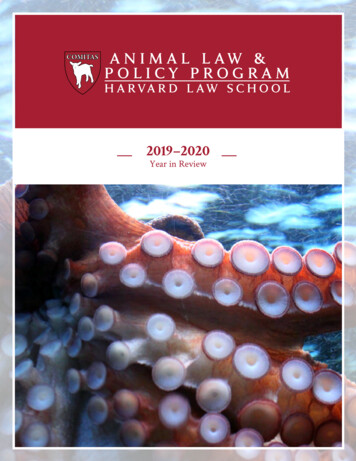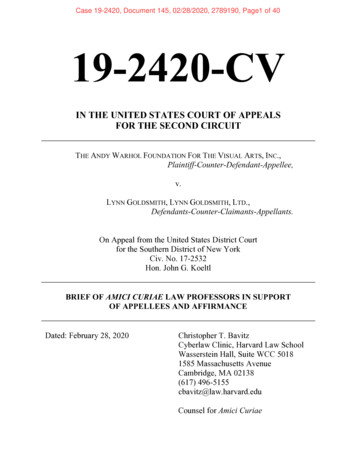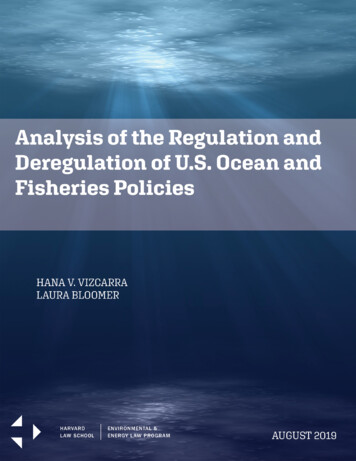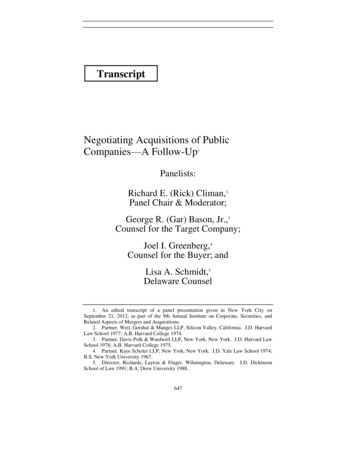
Transcription
TranscriptNegotiating Acquisitions of PublicCompanies—A Follow-Up1Panelists:Richard E. (Rick) Climan,2Panel Chair & Moderator;George R. (Gar) Bason, Jr.,3Counsel for the Target Company;Joel I. Greenberg,4Counsel for the Buyer; andLisa A. Schmidt,5Delaware Counsel1. An edited transcript of a panel presentation given in New York City onSeptember 21, 2012, as part of the 9th Annual Institute on Corporate, Securities, andRelated Aspects of Mergers and Acquisitions.2. Partner, Weil, Gotshal & Manges LLP, Silicon Valley, California. J.D. HarvardLaw School 1977; A.B. Harvard College 1974.3. Partner, Davis Polk & Wardwell LLP, New York, New York. J.D. Harvard LawSchool 1978; A.B. Harvard College 1975.4. Partner, Kaye Scholer LLP, New York, New York. J.D. Yale Law School 1974;B.S. New York University 1967.5. Director, Richards, Layton & Finger, Wilmington, Delaware. J.D. DickinsonSchool of Law 1991; B.A. Drew University 1988.647
648PENN STATE LAW REVIEW[Vol. 117:3IndexI.II.INTRODUCTION . 648CONFIDENTIALITY AGREEMENT . 650A. Use Restriction . 651B. Disclosure Restriction . 658C. Standstill Provision . 665D. Liability Disclaimer/Non-Reliance Provision . 671III.DEAL STRUCTURE: RULE 14E-5 AND THE “DUAL TRACK”APPROACH . 676IV.DEFINITIVE ACQUISITION AGREEMENT—TENDER OFFERCONDITIONS . 679A. “Accuracy of Representations” Condition . 680B. Condition Relating to Governmental Antitrust Approvals . 687C. Condition Relating to Third Party Consents . 689D. Litigation Condition . 691V.DEFINITIVE ACQUISITION AGREEMENT—BOARDRECOMMENDATION COVENANT. 693EXHIBIT 1 . 700EXHIBIT 2 . 704I.INTRODUCTIONRICK CLIMAN:(Moderator)Our topic this morning is negotiatingacquisitions of publicly traded companies. Wehave on the panel Gar Bason of Davis Polk &Wardwell here in New York, and JoelGreenberg of Kaye Scholer, also here in NewYork.They are going to be our leadnegotiators today. We also have Lisa Schmidt,a director at the Delaware law firm ofRichards, Layton & Finger. My name is RickCliman. I am a partner in the Mergers &Acquisitions Group at Weil, Gotshal & Mangesin Silicon Valley, and I will be chairing andmoderating this session.Last year on this panel we addressed a numberof different facets of public companyacquisitions.We discussed the way westructure these deals; we discussed the
2013]NEGOTIATING ACQUISITIONS OF PUBLIC COMPANIES649negotiation of standstill provisions; wediscussed the negotiation of exclusivityagreements; and we discussed the negotiationof the definitive acquisition agreement. In ourdiscussions relating to the definitive acquisitionagreement, we focused in particular onacquisitions structured as friendly tender offersand, in that context, we examined the“mechanical” provisions of that agreement, aswell as the deal protection provisions and theconditions to the buyer’s obligation to purchasethe shares tendered in response to its tenderoffer. We also talked about strategies foraddressing antitrust issues.Thanks to the Penn State Law Review, we havean edited transcript of last year’s presentation,6and we’ve included it in the materials for thissession. You should turn to that editedtranscript now, because we’re going to bereferring to it frequently today.Instead of covering the same ground wecovered last year, we’re going to use the editedtranscript as a point of departure—a jumpingoff point. This morning we’re going to cover anumber of topics that we did not have theopportunity to discuss last year, including sometopics that have become particularly relevant asa result of regulatory and judicialdevelopments over the past year. We willcontinue to focus on “two-step” acquisitionsinvolving friendly tender offers,7 althoughmuch of our discussion today will also apply toacquisitions structured as one-step mergers.For a good chunk of our session today, we willrevert to the format of a mock negotiation, with6. Richard E. Climan, George R. Bason, Frederick R. Green & Joel I. Greenberg,Negotiating Acquisitions of Public Companies in Transactions Structured as FriendlyTender Offers, 116 PENN ST. L. REV. 615 (2012) [hereinafter Friendly Tender Offers].7. See id. at 620-36.
650PENN STATE LAW REVIEW[Vol. 117:3Gar Bason playing the role of the targetcompany’s outside lawyer and Joel Greenbergplaying the role of the buyer’s outside lawyer.Lisa Schmidt will chime in with herobservations on Delaware law.II. CONFIDENTIALITY AGREEMENTRICK CLIMAN:(Moderator)We’re going to begin this morning with one ofthe preliminary documents that gets negotiatedearly in the process of acquiring a publiccompany—the confidentiality agreement. Lastyear we examined one very importantprovision in the confidentiality agreement, theso-called “standstill” provision. This is theprovision that limits the prospective buyer’sability to go hostile on the target company for astipulated period of time. We’re not going torenegotiate that provision now; you can take alook at the edited transcript of last year’ssession for an illustration of how thatnegotiation might proceed.8 Instead, we’regoing to assume today that the parties havealready negotiated and come to agreement onthe terms of the standstill; and we’re going toassume in particular that they’ve agreed to a15-month standstill period. So, for a period of15 months, the prospective buyer has agreednot to commence a hostile tender offer for theacquisition of any target company shares andnot to take any other similarly hostile orcoercive action vis-à-vis the target company.With the standstill provision already fullynegotiated, we’re going to look at some otherkey provisions of the confidentialityagreement. These are provisions that have8.See id. at 636-50.
2013]NEGOTIATING ACQUISITIONS OF PUBLIC COMPANIES651been thrust into the spotlight by a couple ofrecent Delaware decisions, Vulcan9 and RAA,10both of which have had a noticeable effect onthe way confidentiality agreements are beingnegotiated today.You should have in front of you [Exhibit 1],11which contains some excerpts from the targetcompany’s form of confidentiality agreement,as drafted by the target company’s lawyer, GarBason. Behind that you will find [Exhibit 2],12which contains some excerpts from theprospective buyer’s response to thatconfidentiality agreement, drafted by theprospective buyer’s lawyer, Joel Greenberg.Let’s take a look at section 1 of the targetcompany’s form of confidentiality agreement,which is really the guts of the agreement. Itcontains two basic prohibitions—the “twocommandments,” as we sometimes refer tothem—directed at the prospective buyer. Thefirst commandment is enshrined in section1(a): thou shalt not use the target company’sconfidential information, except for thespecific purpose indicated.The secondcommandment is enshrined in section 1(b) ofthe confidentiality agreement: thou shalt notdisclose the target company’s confidentialinformation, except as specifically permitted insection 4 of the confidentiality agreement.A.Use RestrictionRICK CLIMAN:(Moderator)We’re going to focus initially on the firstcommandment, the use restriction. Joel, let’slook at [Exhibit 2], which lays out your9. Martin Marietta Materials, Inc. v. Vulcan Materials Co., 56 A.3d 1072 (Del. Ch.2012), aff’d, 2012 WL 2783101 (Del. July 10, 2012).10. RAA Mgmt., L.L.C. v. Savage Sports Holdings, Inc., 45 A.3d 107 (Del. 2012).11. See infra pp. 700-03 (Exhibit 1).12. See infra pp. 704-06 (Exhibit 2).
652PENN STATE LAW REVIEW[Vol. 117:3requested changes to the target company’soriginal form of confidentiality agreement. Itappears you didn’t particularly like the wayGar drafted the permitted use language in theuse restriction.Gar’s permitted use language allows yourclient, the prospective buyer, to useconfidential information “for the specificpurpose of considering, evaluating andnegotiating a possible negotiated transactionbetween the parties.” You replaced it withsomething a lot broader. You replaced it withlanguage specifying that your client can useconfidential information “for the purpose ofconsidering, pursuing and/or facilitating apossible transaction involving the TargetCompany or any of its stockholders, includingan unsolicited or uninvited acquisition of theTarget Company or any of its securities.” Inote that, among other things, you shortenedthe term “possible negotiated transaction” to“possible transaction”—you removed the term“negotiated”—and you replaced the word“between” with the more general word“involving.” What’s going on here?JOEL GREENBERG:(Counsel for Buyer)Well, I have to give Gar credit for being, in thewords of former Chancellor Chandler, a“forthright negotiator.”Gar’s originallanguage is very clear as to what he’s gettingat, which is to limit our use of confidentialinformation to a negotiated transactionbetween the parties.That may soundreasonable, but remember we’ve justnegotiated a 15-month standstill, and the userestriction is for a longer period. As far as I’mconcerned, the standstill period is the agreeddeal as to when my client is precluded fromgoing hostile on the target company. I don’twant language anywhere else in theconfidentiality agreement that basically says,
2013]NEGOTIATING ACQUISITIONS OF PUBLIC COMPANIES653“now that we have all this confidentialinformation, we can’t use it in connection witha proxy contest, a hostile tender offer or anyother approach we might need or decide to takeafter the 15-month standstill period is over.”For 15 months we are barred from goinghostile, and that’s the deal. Afterwards, weshould be free to do whatever we choose to do.GAR BASON:(Counsel for Target)Look, I respect that view, but it seemsanomalous to me. As a business matter, myclient, the target company, thinks that while itsconfidential information can be used for afriendly deal, it shouldn’t be used for a hostiledeal. We understand that at the end of 15months you’ll have the ability to do anythingyou like. We just don’t think that you shoulduse our confidential information to do that.This isn’t just an emotional thing. The fact isthat your client’s use of my client’sconfidential information gives your client anedge over anyone else in the market. It’s anadvantage that we don’t think is appropriate orfair.JOEL GREENBERG:(Counsel for Buyer)Two points. Remember, this edge over anyoneelse is going to be based on information that is,by definition, at least 15 months old. It’s notas if my client will have current confidentialinformation. But more important, there is atotal lack of certainty on my client’s part as towhether we can do a transaction without yourclient alleging that we are “using confidentialinformation.”Our senior management team is notschizophrenic. They can’t divide their brainsinto two parts and say this part has theconfidential information and it’s this other partthat’s deciding to go hostile. And rememberthe way we’ve defined “confidentialinformation.” It includes derivatives of the
654PENN STATE LAW REVIEW[Vol. 117:3stuff you give my client. It’s not just the pieceof paper that has a budget, for example; it’salso the analysis my client makes from thatbudget. If your client decides to litigate, it’sgoing to be very difficult for my client to takethe position that my client has not “usedconfidential information” in deciding to gohostile.GAR BASON:(Counsel for Target)Joel, it’s not that complicated to put together a“clean team.” Your client could have both aclean team and—I won’t call it a “dirtyteam”—another team; and the other team is theone that can look at my client’s confidentialdata. That data would be walled off, so thatmembers of the clean team would not haveaccess to it, and only the clean team memberswould be permitted to get involved in thedecision as to whether your client will gohostile on my client. If you want to talk withus about whether folks who are not on theclean team can report on some high-level basisto clean team members about their findings, wemay be able to accommodate that. But I justdon’t think it’s appropriate for your client touse my client’s confidential data to launch ahostile bid for my client.RICK CLIMAN:(Moderator)Joel, we see clean teams used frequently in duediligence investigations. What’s wrong withGar’s proposal? Why not identify the teamthat would make the decisions regarding anyhostile approach your client might want tomake, and have that team walled off from theteam that receives and reviews the targetcompany’s confidential information?JOEL GREENBERG:(Counsel for Buyer)Clean teams work just fine for certain kinds ofinformation, and if we were talking aboutwalling off technical specifications of productsor detailed customer-by-customer analyses ofcosts and revenues, that would probably be
2013]NEGOTIATING ACQUISITIONS OF PUBLIC COMPANIES655acceptable. But what we can’t do is wall offmy client’s board of directors and seniormanagement from being able to have in mind,for example, the synergy estimates developedin the context of my client’s due diligenceinvestigation.When my client’s boardmembers make their decision to go hostile onthe target company, they’re going to know thata year and a half ago we concluded we couldsave a billion dollars a year by combining thesetwo businesses. You can’t erase that. It’s quiterelevant to deal pricing, and that kind of highlevel strategic information is very hard to walloff because inevitably the decision makers whoneed to consider it, at least in a deal thissubstantial to my client, are top-level peoplewho can’t be replicated on two separate teams.RICK CLIMAN:(Moderator)Joel, can you walk us through your suggestedpermitted use language? You did a lot morehere than just eliminate the word “negotiated.”You actually added words like “facilitating,” asin “facilitating a possible transaction.” Isuspect that might tie into things like proxycontests and other hostile tactics that aren’tnecessarily “transactions” per se.JOEL GREENBERG:(Counsel for Buyer)That’s right, Rick. It’s always important whendrafting contractual language to take intoaccount the experience of others, in this casewhat happened with Martin Marietta in theVulcan litigation earlier this year. And some ofthe arguments that were made there—somesuccessful, some ultimately not decided—included such things as the word “between”implying that it is an entity-to-entitytransaction and not a transaction involving adirect approach to stockholders.13 Similarly,words like “negotiating” and “implementing”may not cover a preparatory action we need to13.See Vulcan Materials Co., 56 A.3d at 1106.
656PENN STATE LAW REVIEW[Vol. 117:3take, such as a proxy contest to replace thetarget company’s board members so that wecan get the new board to pull the targetcompany’s poison pill. That proxy contestfacilitates an ultimate deal, but it may verywell not be a “transaction” that’s part of theultimate deal. So, what we have tried to dohere, as Gar did in his language, is be candidand forthright about what we’re seeking toachieve. We want to be able to do things topursue and facilitate a transaction even if thesethings are preparatory in nature and don’tthemselves constitute a “transaction.”Along the same lines, we don’t want to have anotion that the transaction has to be betweentwo entities. A hostile tender offer isn’t atransaction “between” the buyer and the targetcompany. That’s why we said involving thetarget company or any of its stockholders. Andthen, again to avoid any doubt—because quitehonestly it’s not my objective in negotiatingthese things to drive business to my litigationdepartment—we said quite specifically that wecan proceed on an unsolicited or uninvitedbasis.RICK CLIMAN:(Moderator)Joel, the Vulcan case isn’t the first case to pointout some of these key wording distinctions inthe verbiage of confidentiality agreements.Wasn’t there a previous Canadian case thataddressed these issues?JOEL GREENBERG:(Counsel for Buyer)Yes, there was a Canadian case that addressedthese issues. The court in that case basicallytook the use restriction and turned it into aninjunction against a hostile takeover.14 TheVulcan decision has received a lot moreattention than the Canadian case for a couple ofreasons. First, because Delaware is such a key14.See Friendly Tender Offers, supra note 6, at 642 n.45.
2013]NEGOTIATING ACQUISITIONS OF PUBLIC COMPANIES657forum for these types of disputes and, second,because the Vulcan case was litigated verythoroughly.It’s hard to imagine anyarguments that weren’t made by the parties inthat case. The Chancery Court’s opinion is awonderful analysis, provision by provision, ofthings people do in confidentiality agreements.What we’re seeing in the market now arepeople responding to that.If the word“between” can be argued to connote“negotiated,” which was certainly an argumentthat Chancellor Strine found to be valid on thefacts of the Vulcan case,15 then, if you want tobe able to go hostile, you don’t use the word“between.” You use the word “involving.”RICK CLIMAN:(Moderator)Gar, in our hypothetical negotiation, the partieshave agreed to an explicit 15-month standstill.And as Joel pointed out, the narrow userestriction that you put forward could operateas a back-door standstill even after theexpiration of the negotiated 15-month period.That’s because, as a practical matter, it’s veryhard for Joel’s client to go hostile in month 16without using at least some of the confidentialinformation that your client provided to Joel’sclient in due diligence.In an actualnegotiation, would you agree to the expandedpermitted use language [in Exhibit 2] that Joelhas proposed to address this issue?GAR BASON:(Counsel for Target)Yes, I would. If the deal is 15 months for theterm of the standstill, my client shouldn’t belooking for semi-sneaky back-door ways ofextending it.In some senses, this is partly an emotionalissue. Saying that, I don’t mean to downplayit. But in the early phases of the negotiations,when you are having discussions CEO-to-CEO15.See Vulcan Materials Co., 56 A.3d at 1115.
658PENN STATE LAW REVIEW[Vol. 117:3about a friendly deal, to have the buyer’slawyer send over a confidentiality agreementcontaining an explicit acknowledgement thatafter 15 months the buyer might decide to dothis unilaterally and go hostile, that can reallytrigger a negative emotional reaction on thepart of the target company’s CEO. But if thetarget company’s counsel is thoughtful aboutthe issue, it’s not one he will fight hard on.JOEL GREENBERG:(Counsel for Buyer)B.One way this is resolved in the marketplace isto simply make the time periods coterminous,so that the use restriction and the standstillprovision run for the same period of time.Then, I don’t need to fuss about the permitteduse language because the use restrictionterminates when the standstill terminates.Disclosure RestrictionRICK CLIMAN:(Moderator)Now, let’s take a look at the “secondcommandment,” which appears in section 1(b)of the confidentiality agreement. It’s thedisclosure restriction.It says that theprospective buyer may not disclose any of thetarget company’s confidential information,except as permitted in section 4.I turn the page to section 4, Gar, and there I seethat in section 4(a)(iii) you’re permitting theprospective buyer to disclose your client’sconfidential information “to the extent requiredby applicable law or governmental regulationor by valid legal process.” That seems fair. Ifthe prospective buyer is legally required to dosomething, it should not be precluded by thisconfidentiality agreement from doing it. But inthe very next sentence you’ve added someverbiage that I haven’t seen in negotiatedconfidentiality agreements before Vulcan. Thissentence seems to say that, under certaincircumstances, even after the 15-month
2013]NEGOTIATING ACQUISITIONS OF PUBLIC COMPANIES659standstill period expires, the buyer may notmake use of the “required by law” exemptionin clause (iii)(A). And one circumstance underwhich the prospective buyer is prohibited fromusing this “required by law” exemption iswhere the prospective buyer decides to make ahostile tender offer or to accumulate targetcompany shares. Yet, as we’ve just confirmedin the context of discussing the use restriction,beginning in month 16 the prospective buyershould be free to do just about anything of ahostile or coercive nature. So please explainwhat this additional sentence is intended to doand why it’s here.GAR BASON:(Counsel for Target)Well, I admire Joel’s style because, uneducatedas I may have been, I had always thought thatprovisions like section 4(a)(iii) were intendedto address the prospective buyer’s need to beable to respond to a subpoena. But afterreading the lower court’s decision in Vulcan, Irealize that a prospective buyer could arguethat this provision goes further than that. Theprospective buyer could argue that thisprovision comes into play when theprospective buyer unilaterally makes adecision, after the expiration of the 15-monthstandstill period, to go out and buy targetcompany shares. The prospective buyer couldreason as follows: “Well, of course, under theU.S. securities laws, I must either (1) discloseall material nonpublic information I have aboutthe target company before I purchase targetcompany shares, or (2) abstain from purchasingthose shares. And because I want to purchasetarget company shares, I am ‘required bylaw’—by U.S. securities laws—to disclose allmaterial confidential information in mypossession. Section 4(a)(iii)(A) permits me todo just that.”Now it’s not at all clear to me that the
660PENN STATE LAW REVIEW[Vol. 117:3prospective buyer’s argument that thisdisclosure is “required by law” would stand up.In fact, there is authority suggesting thatdisclosure in this context is not “required bylaw.”16 But I’m not inclined to take anychances, especially in light of the Vulcanopinion, and that’s why I put this sentence inhere at the end of section 4(a). I want to makeit clear that Joel’s client can’t decide to gohostile and then use this “required by law”exemption to publish my client’s sensitiveinformation.RICK CLIMAN:(Moderator)Joel, you’ve crossed out [in Exhibit 2] thissentence at the end of section 4(a), so I assumeyou want to retain the flexibility to do justthat—to make any disclosure of confidentialinformation legally required to enable yourclient to proceed with a tender offer. In fact, inyour mark-up [in Exhibit 2], you even addedlanguage, in parentheses at the end of clause(a)(iii), to make it crystal clear that you can dothis.JOEL GREENBERG:(Counsel for Buyer)Correct. I made it clear that my client candisclose confidential information “as requiredby law,” even if the law becomes applicableonly as a result of a specific decision on thepart of my client, such as the decision to gohostile.RICK CLIMAN:(Moderator)Gar, you might use the term “bootstrapping” todescribe what Joel is seeking to do.GAR BASON:(Counsel for Target)That word does, in fact, capture the notion.What Joel is seeking to be able to do reminds16. Chancellor Strine expressly declined to reach this issue in Vulcan Materials Co.See id. at 1135 n.241. Vulcan had argued that Martin Marietta could not “manufacture itsown legal requirement” and then use that requirement to permit disclosure of informationthat was otherwise required to be kept confidential (citing, inter alia, ARTHUR LINTONCORBIN, CORBIN ON CONTRACTS § 76.11; Peckham v. Indus. Sec. Co., 113 A. 99 (Del.1921)). See Vulcan Materials Company’s Post-Trial Brief at 55-56, Martin MariettaMaterials, Inc. v. Vulcan Materials Co., 56 A.3d 1072 (2012) (No. 7102-CS).
2013]NEGOTIATING ACQUISITIONS OF PUBLIC COMPANIES661me of the child who murders his parents andpleads for sympathy from the court becausehe’s an orphan. It’s a classic bootstrap.RICK CLIMAN:(Moderator)Joel . . .JOEL GREENBERG:(Counsel for Buyer)Interestingly, this is one issue that ChancellorStrine avoided in Vulcan. The Chancellordeclined to decide whether voluntary conductthat triggered a disclosure requirement wascovered, because he got to his decision in adifferent way.17 But this issue goes back to thisbasic business premise: there’s no legal waywe can do a hostile offer without disclosing atleast some matters that are protected by theconfidentiality agreement; therefore, theconfidentiality agreement must permit thatdisclosure after the standstill period hasexpired. Take an obvious example: the priornegotiations between the parties regarding apossible friendly acquisition of the targetcompany by my client. The SEC’s regulationsrequire my client to write a “background”section in its tender offer document thatdiscloses these negotiations.RICK CLIMAN:(Moderator)Your point, Joel, is that those prior negotiationsconstitute confidential information under theconfidentiality agreement, but the SEC’s tenderoffer regulations might require disclosure ofthese negotiations if your client decides tomake a hostile tender offer in month 16.GAR BASON:(Counsel for Target)But I think that’s okay. We’ll agree to thatdisclosure. Disclosing past negotiations won’tbe troubling to my client.JOEL GREENBERG:(Counsel for Buyer)But there might be other things that fall intothat category as well. If, for example, my17.See Vulcan Materials Co., 56 A.3d at 1113.
662PENN STATE LAW REVIEW[Vol. 117:3client has worked out synergy numbers basedon confidential information, I don’t see howmy client can go out into the market with atender offer without disclosing those numbers.Are you going to be okay with that too?Bootstrapping may seem to be a bad thing todo, and it’s certainly the prejudicial term agood advocate would use. However, if we goback to the basic business premise that, afterthe 15-month standstill period, my client issupposed to be able to unilaterally launch ahostile tender offer, then my client needs to beable to do the things that go along with that. Ifwe wanted to develop a more refined approach,I would say that you can probably make somedistinction in the confidentiality agreementbetween types of confidential information that,if disclosed, would be really harmful and thosethat would not. If Gar is representing the CocaCola Company as the target of an acquisition, Ido not want or need the right to put the secretformula for Coke Classic in my tender offerdocuments.GAR BASON:(Counsel for Target)Right. That’s not the same thing as disclosingpast acquisition negotiations. There is often anargument made that the prospective buyerneeds to let the target company’s confidentialinformation go stale before initiating a hostilebid. Most targets would not like to see theirraw confidential information disclosed if it’sstill market sensitive.But I agree thatdisclosing past negotiations should not becontroversial. And we would think of a way toaddress the synergies point. But this is whatpushes people towards the solution that Joelarticulated before, which is simultaneoustermination of the standstill provision and otherrestrictions in the confidentiality agreement.
2013]NEGOTIATING ACQUISITIONS OF PUBLIC COMPANIES663JOEL GREENBERG:(Counsel for Buyer)Yes. And clearly, if Gar’s client had disclosedthe secret Coke Classic formula somewhere inthe course of my client’s due diligenceinvestigation, that would be excepted from thetermination of the disclosure restriction.GAR BASON:(Counsel for Target)Right.RICK CLIMAN:(Moderator)Joel, you wouldn’t have seen language like thelanguage Gar included at the end of section4(a) three years ago in an M&A-relatedconfidentiality agreement, would you? Isn’tthis something that target companies are onlynow starting to address in the wake of theVulcan decision?JOEL GREENBERG:(Counsel for Buyer)That’s right. Perhaps target companies shouldhave included this type of language in the past.But, given that the “bootstrap” issue wasargued in Vulcan and Chancellor Strinespecifically declined to decide that issue,18 theVulcan case invites the parties to do someprivate ordering here.GAR BASON:(Counsel for Target)And that “bootstrap” issue has been lurking outthere for a while.RICK CLIMAN:(Moderator)Have you in fact seen an increase in thefrequency with which parties have specificallyaddressed this particular issue since the Vulcandecision, Gar?GAR BASON:(Counsel for Target)I’d say yes, certainly.JOEL GREENBERG:(Counsel for Buyer)I’d say yes too. And I’d also say that a relatedissue the parties are addressing a lot morecarefully now since Vulcan is what it means foran action to be “required by law.” Chancellor18.See id.
664PENN STATE LAW REVIEW[Vol. 117:3Strine went through a detailed nts, on one hand, and what he called“external demands,” like subpoenas, on theother.19And the so-called notice and vetting provisionsthat you often find in confidentialityagreements—the provisions that require theprospective buyer to give advance notice to thetarget company before making certain legallycompelled disclosures of the target company’sconfidential information—also did not get asmuch attention as they should have beforeVulcan. It’s a kind of in
Law School 1977; A.B. Harvard College 1974. 3. Partner, Davis Polk & Wardwell LLP, New York, New York. J.D. Harvard Law School 1978; A.B. Harvard College 1975. . much of our discussion today will also apply to acquisitions structured as one-step mergers. For a good chunk of our session toda
